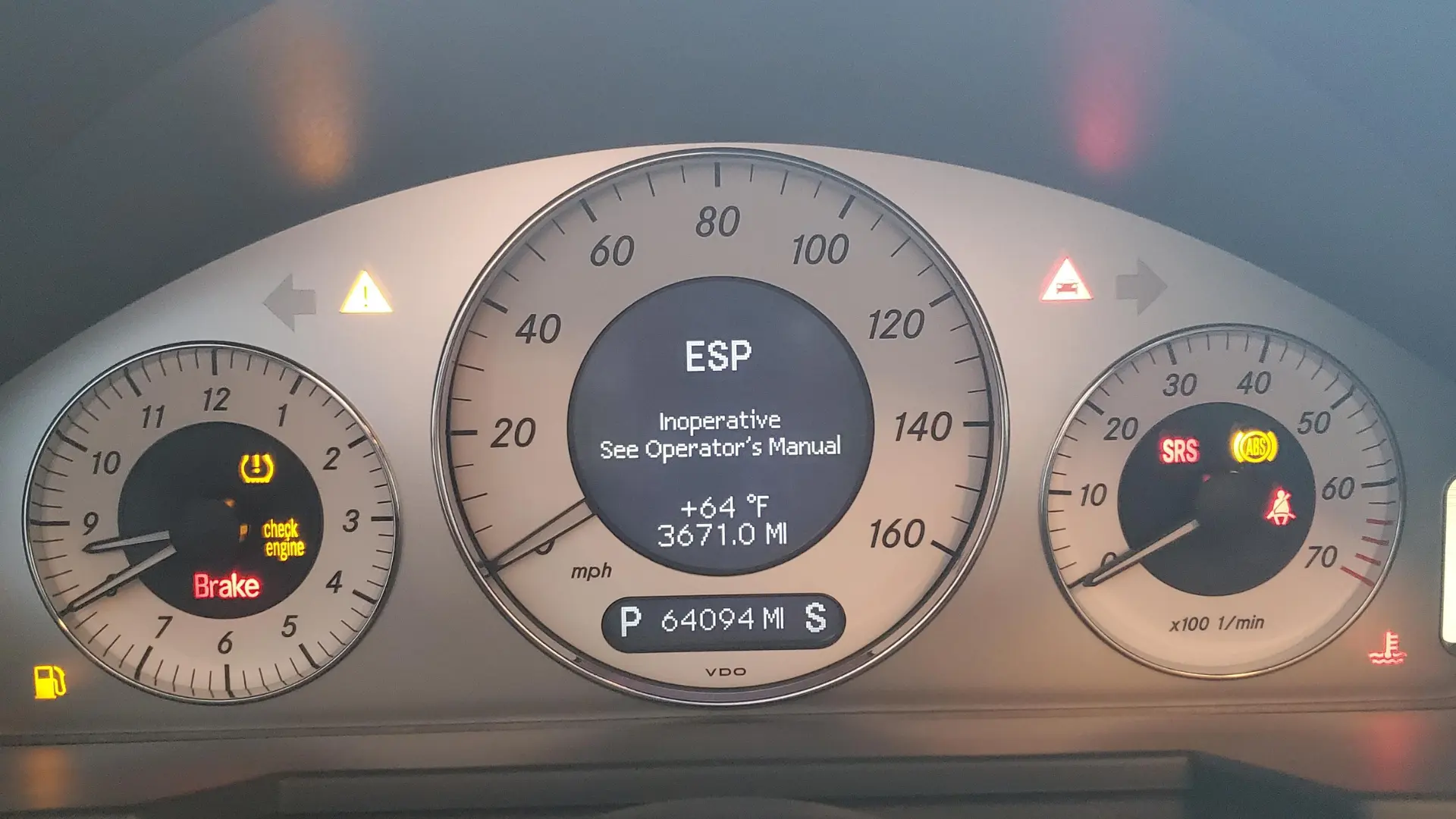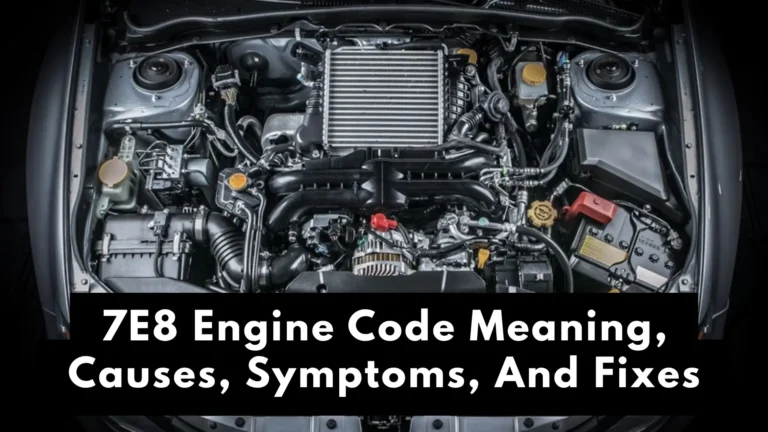Mercedes-Benz ESP Inoperative Warning, Causes, And Fixes!
If you’re a proud owner of a Mercedes-Benz, then you know the joy that comes with driving such an exceptional vehicle. However, encountering warning messages can be alarming, especially when it involves something as crucial as the Electronic Stability Program (ESP).
The “Mercedes-Benz ESP Inoperative” warning light is more than just a simple alert; it’s your car’s way of telling you that something needs attention. But don’t worry! With some understanding and quick fixes, you’ll have everything back to normal in no time. Let’s dive into what this message means and how to get your beloved Benz back on the road safely and confidently.
Understanding Mercedes-Benz ESP Inoperative Message
When you see the Mercedes-Benz ESP Inoperative message on your dashboard, it can be concerning. This warning indicates that the Electronic Stability Program (ESP) is not functioning properly. The ESP system plays a crucial role in maintaining vehicle stability during challenging driving conditions.
The primary goal of the ESP is to help prevent skidding and loss of traction. It works by detecting when a car might lose grip and intervenes by adjusting brake force to individual wheels or reducing engine power. When this system is inactive, your vehicle may become less stable, especially in slippery situations.
Seeing this warning light doesn’t mean your car will immediately fail; however, it’s essential to address it quickly. Ignoring the issue could lead to decreased safety while driving, particularly in adverse weather conditions like rain or snow.
Understanding why this message appears requires some insight into potential underlying issues within your vehicle’s systems. Various factors can trigger the alert—from faulty sensors and wiring problems to low battery voltage or even software glitches.
If you encounter this warning message, don’t panic! It’s best to have an expert diagnose the problem as soon as possible so you can get back on track with confidence behind the wheel of your Mercedes-Benz.
How the ESP System Works in Mercedes-Benz Vehicles
The Electronic Stability Program (ESP) is a crucial safety feature in Mercedes-Benz vehicles. It helps maintain control during challenging driving conditions. When the car senses a loss of traction, it intervenes to help prevent skidding or fishtailing.
The ESP system works by monitoring various sensors throughout the vehicle. These sensors track wheel speed, steering angle, and lateral acceleration. When they detect that the vehicle is starting to lose grip, ESP activates automatically.
Once activated, ESP selectively applies brakes to individual wheels. This action helps steer the car back on course and stabilize it without driver input. It’s like having an invisible co-pilot keeping you safe on slippery roads or during sharp turns.
Additionally, ESP integrates with other systems such as ABS (Anti-lock Braking System). Together they ensure optimal handling and braking performance when you need it most. The collaboration between these systems enhances overall safety for both drivers and passengers.
In Mercedes-Benz vehicles, the ESP system is designed to be intuitive and unobtrusive. Most drivers won’t even notice its intervention until they truly need it—like during sudden weather changes or emergency maneuvers. This seamless operation highlights why Mercedes-Benz prioritizes safety features in their engineering design.
Common Causes of ABS and Mercedes ESP Inoperative Message
Seeing the “ESP Inoperative” message on your Mercedes-Benz dashboard can be concerning. There are a few common culprits behind this warning, and understanding them can save you time and stress.
One frequent cause is a malfunctioning wheel speed sensor. This sensor tracks the rotation of each wheel to help manage traction control. If it fails or gets dirty, it sends incorrect signals to the ESP system, triggering that pesky warning light.
Another possible issue could be low brake fluid levels. The ESP system relies on proper brake function for optimal performance. When fluid levels drop too low, it can disrupt the entire braking system’s efficiency and lead to an inoperative message.
Electrical issues also play a significant role in ESP warnings. Faulty wiring or blown fuses connected to the ABS and ESP modules may result in communication breakdowns between components. A simple inspection might reveal where things have gone awry.
Worn-out tires can contribute to this problem as well. Uneven tire pressure or significant wear changes how your vehicle handles during acceleration or braking, which might confuse the ESP system into thinking there’s trouble ahead.
If you’re facing this warning light frequently, it’s essential to consult with a qualified technician who understands these systems thoroughly.
Resetting the Mercedes-Benz ESP Warning Light
If you see the Mercedes-Benz ESP warning light, it can be a bit concerning. Fortunately, resetting this light is often straightforward. First, start by checking for any underlying issues with your vehicle’s systems. Sometimes, it’s just a temporary glitch that needs addressing.
Once you’ve ensured everything is functioning well, you can try resetting the warning light yourself. Begin by turning off your car and removing the key from the ignition. Wait for about 30 seconds to allow all systems to power down completely.
Next, insert the key back into the ignition without starting the engine yet. Turn it to position two — just before cranking up — and leave it there for around 10 seconds before switching it off again. This simple action may reset various electronic systems in your vehicle.
Afterward, turn on your car as usual and check if the ESP warning light has disappeared from your dashboard. If not, don’t panic; sometimes further diagnostics are needed if an issue persists.
In cases where manual resets don’t work or you’re still experiencing problems after being checked out thoroughly at a shop, consulting with a professional mechanic might be necessary for more detailed troubleshooting and repairs.
Conclusion
Experiencing the Mercedes-Benz ESP Inoperative warning can certainly be concerning, especially when driving. It’s essential to understand that this message is not just a random alert; it indicates an issue with your vehicle’s safety systems. Addressing it promptly ensures your car maintains its exceptional performance and safety.
The causes of the ESP inoperative warning can vary widely, from minor electronic glitches to more serious concerns like sensor failures or brake system issues. Identifying the root cause is crucial for effective resolution. Sometimes, simply resetting the system might do the trick, but other times professional diagnostic assistance may be necessary.
Regular maintenance plays a key role in preventing these warnings from surfacing unexpectedly. Keeping up with scheduled service checks helps catch potential problems before they escalate into bigger headaches down the road.
If you ever find yourself uncertain about how to proceed after seeing that warning light, don’t hesitate to consult your owner’s manual or reach out to a certified technician familiar with Mercedes vehicles. They have access to specialized tools and knowledge tailored specifically for your model.
Staying informed about your car’s systems empowers you as a driver. With some vigilance and timely action, you’ll keep enjoying everything that makes driving a Mercedes-Benz such an exhilarating experience.
Related Article:
Mazda Battery Management System Malfunction
Frequently Asked Questions
What does the ESP inoperative warning mean?
The ESP (Electronic Stability Program) inoperative warning indicates a malfunction within the stability control system. It means your vehicle may not be able to correctly assist with traction or stability during challenging driving conditions.
Can I still drive my car with the ESP light on?
While you can technically continue driving, it’s important to exercise caution. The absence of stability assistance can make handling more difficult, particularly in slippery conditions.
How do I reset the ESP light on my Mercedes-Benz?
Resetting typically involves addressing any underlying faults first. Once resolved, you can use an OBD-II scanner or have a professional mechanic reset it through their diagnostic tools.
Is there a way to prevent future problems with my ESP system?
Regular maintenance is key. Ensure that your brake systems are checked as part of routine inspections and promptly address any dashboard warnings when they appear.
Should I take my vehicle to a dealership for repairs related to the EPS warning?
While dealerships have specialized knowledge about these systems, many qualified independent mechanics can also handle such repairs efficiently without compromising quality.

Kevin Morgan is an ASE-certified automotive engineer and blogger with over 15 years of experience in vehicle systems design, performance testing, mechanics, and diagnostics. He is deeply passionate about automotive excellence. As a contributing author at CarClinicCentral, Kevin shares his expertise with enthusiasts, providing valuable market insights, updates, and trends.


![Mitsubishi ASX Problems & Issues: Causes and Fixes [2025] 3 mitsubishi asx problems](https://carcliniccentral.com/wp-content/uploads/2025/09/mitsubishi-asx-problems-768x432.webp)
![Mercedes A9 Service: Cost, Checklist, And Code [Guide 2025] 4 mercedes a9 service](https://carcliniccentral.com/wp-content/uploads/2025/08/mercedes-a9-service-768x432.webp)
![Honda A13 Service: Cost, Checklist, and Code Info [2025] 5 honda a13 service](https://carcliniccentral.com/wp-content/uploads/2025/09/honda-a13-service-768x432.webp)
![Mercedes A5 Service: Cost & Checklist [Detailed Guide] 2025 6 mercedes a5 service](https://carcliniccentral.com/wp-content/uploads/2025/08/mercedes-a5-service-768x432.webp)

